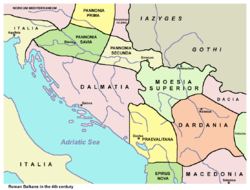This is an old revision of this page, as edited by Maleschreiber (talk | contribs) at 21:07, 13 September 2024 (rv to last non-dispute version among established editors). The present address (URL) is a permanent link to this revision, which may differ significantly from the current revision.
Revision as of 21:07, 13 September 2024 by Maleschreiber (talk | contribs) (rv to last non-dispute version among established editors)(diff) ← Previous revision | Latest revision (diff) | Newer revision → (diff) Group of Roman emperors
The Illyriciani or Illyrian emperors were a group of Roman emperors during the Crisis of the Third Century who were of Illyrian origins and hailed from the region of Illyricum (in the Western Balkans), and were raised chiefly from the ranks of the Roman army (whence they are ranked among the so-called "barracks emperors").
In the 2nd and 3rd centuries, the Illyricum and the other Danubian provinces (Dacia, Raetia, Pannonia, Moesia) held the largest concentration of Roman forces (12 legions, up to a third of the total army), and were a major recruiting ground. The advance of these low-born provincials was facilitated by a major shift in imperial policy from the time of Gallienus (253–268) on, when higher military appointments ceased to be exclusively filled by senators. Instead, professional soldiers of humble origin who had risen through the ranks to the post of primus pilus (which also entailed admission to the equestrian order) were placed as heads of the legions and filled the army's command structure.
The aims of the Illyrian emperors were roughly identical. Given their low origin, they were opposed to the landowning oligarchy and the senatorial order. Since the security of their birthplace depended on it, they considered the defense of the state's territorial integrity a primary task. They saw this in creating a strict soldier-like discipline (a slogan they frequently glorified on their coins) everywhere. In order to pursue this task, they worked on eliminating privileges and autonomies and subordinating one's interests to the interests of the crumbling empire. Thus, their form of rule was military dictatorship. Paired with vim, the Illyrian emperors' rigid notions led to the rise of the Dominate.
Since Decius hailed from the senatorial background, the historical period of the Illyrian emperors proper begins with Claudius Gothicus in 268 and continues in 284 with the rise of Diocletian and the institution of the Tetrarchy. This period was very important in the history of the Empire, since it represents the recovery from the Crisis of the Third Century, a long period of usurpations and military difficulties. All of the Illyrian emperors were trained and able soldiers, and they recovered most of the provinces and positions lost by their predecessors, including Gaul and the eastern provinces. Men of Illyrian or Thraco-Dacian origin however continued to be prominent in the Empire throughout the 4th century and beyond.
The later Valentinic-Theodosian dynasties (364–457 AD) also hailed from the Pannonia region.
List
The following emperors are counted as Illyriciani:
- Decius, ruled AD 249–251
- Herennius Etruscus, ruled AD 251
- Hostilianus, ruled AD 251
- Claudius II "Gothicus", ruled AD 268–270
- Quintillus, ruled AD 270
- Aurelian, ruled AD 270–275
- Probus, ruled AD 276–282
- Diocletian, ruled AD 284–305
- Maximianus "Herculius", ruled AD 286–305
- Constantius Chlorus, ruled AD 305-306
- Galerius, ruled AD 305-311
- Severus II, ruled AD 306–307
- Constantine I, ruled AD 306–337
- Licinius, ruled AD 308-324
- Constantius II, ruled AD 337-361
- Jovian, ruled AD 363–364
- Valentinianus I, ruled AD 364–375
- Valens, ruled AD 364–378
- Gratian, ruled AD 375–383
- Valentinianus II, ruled AD 375–392
- Constantius III, ruled AD 421
- Valentinian III, ruled AD 425-455
- Anastasius I, ruled AD 491–518
- Justin I, ruled AD 518–527
- Justinian I, ruled AD 527-565
- Justin II, ruled AD 565–578
See also List of Roman Emperors for more details.
- High grade cavalry was also called Equites Illyriciani
See also
References
- Odahl 2004, pp. 36–40.
- The Illyrians (The Peoples of Europe) by John Wilkes, 1996, pp. 261–263
- Hahn, István (1992). Harmatta, János (ed.). Az ókori Róma [The ancient Rome]. Budapest: Tankönyvkiadó. p. 372. ISBN 963-18-4313-0.
- The Illyrians (The Peoples of Europe) by John Wilkes, 1996, p. 262-264
- Wilkes 1996, pp. 262–67.
- The Grand Strategy of the Roman Empire: From the First Century A.D. to the Third by Edward N. Luttwak, page 178, "high-grade cavalry (equites Illyriciani)"
Sources
- Wilkes, John (1996) . The Illyrians. Wiley. ISBN 978-0-631-19807-9.
- Kuzmanović, Zorica; Mihajlović, Vladimir D. (2015). "Roman Emperors and Identity Constructions in Modern Serbia". Identities: Global Studies in Culture and Power. 22 (4): 416–432.
- Odahl, Charles Matson (2004). Constantine and the Christian Empire. Routledge. ISBN 0415174856.
| Roman emperors by time period | |||||||||
|---|---|---|---|---|---|---|---|---|---|
| |||||||||